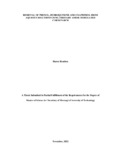Removal of Phenol, Hydroquinone and 2-Naphthol from Aqueous Solutions Using Tertiary Amine Modulated Cornstarch
Abstract
Phenolics are a family of chemical compounds with at least one hydroxyl group attached directly to aromatic group. The sources of phenolics pollutants in water are mainly chemical industries and pharmaceutical. They are harmful and toxic even at modest concentrations. Some of their health effects are irreversible and it is prudent to remove phenolics from water to overcome them. The method that has attracted more attention is adsorption. Major strides have been made over years to search for highly selective and efficient bio-adsorbent for water remediation. Despite substantial achievements, there is need to search for bio-adsorbent which is ecofriendly and efficient. The objectives of the study were to modify cornstarch using triethanolamine and to characterize unmodified and modified cornstarch using Fourier Transform Infrared (FT-IR), to optimize selected adsorption parameters for the removal of phenol, hydroquinone and 2-naphthol in water using aminated cornstarch (ACS) and to determine the adsorption capacity of dried raw cornstarch (RCS) and ACS in removal of phenolic compounds (PCs). Pseudo first and second order kinetic models were used to determine mechanisms involved in both chemisorption and physisorption processes. The Langmuir and Freundlich isotherms were used to determine adsorption capacity of the ACS and whether it was monolayer or multilayer. The modulation of cornstarch was in two steps; chlorination of cornstarch using acetyl chloride reflux in aniline at 70 ℃ and 120 rpm for 5 hours, and amination using triethanolamine refluxed at 40 ℃ and 120 rpm for 3.5 hours. The FT-IR spectrum of the ACS showed strong broad band with increased intensity at 3295.44cm-1 which confirmed C-N stretch of amine group and N-H stretch of amine salt were anchored. The efficiency of modified cornstarch in phenolics removal at different pH levels, contact time, initial phenolics concentration and dosage of ACS in aqueous media at constant temperature (25±1 ℃) were investigated. Batch studies revealed that maximum removal of PCs was realized at a contact time of 10 mins, pH of 5.0-6.0 and constant temperature of 25±1 ℃ for the phenol, hydroquinone and 2-naphthol compounds. The uptake increased with increase in the dosage of ACS and initial concentration of phenolics. The rate of adsorption process was best described by the pseudo – second order kinetic model, indicating that the rate mechanism was chemisorption. The maximum uptake of PCs occurred at initial concentration of 10ppm and then plateaued. The batch experimental data obtained best fitted into the Langmuir isotherm with regression coefficient, R2=0.9998, 0.9999, 1.000 and monolayer adsorption capacities of 4.297, 4.585 and 5.048 mg/g for phenol, hydroquinone and 2-naphthol respectively. The adsorption process was monolayer and homogenous in nature. These adsorption capacities were relatively higher than many reported processes, thus indicating that the ACS an effective adsorbent for removal of PCs from aqueous media. The findings from this study provides an alternative biopolymer that may be used for the removal of phenolic compounds from water.

